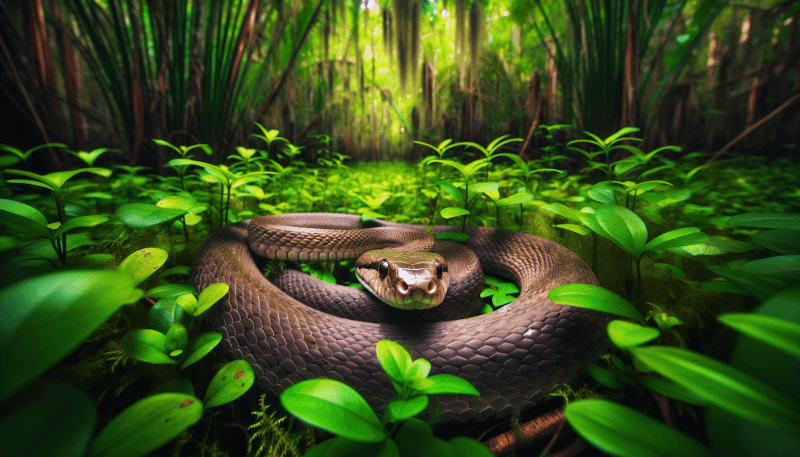Florida is home to a diverse range of wildlife, and that includes a significant number of snake species. From the venomous ones to the harmless and elusive, the Sunshine State boasts an impressive array of slithering inhabitants. If you’ve ever wondered just how many snake species call Florida their home, this article will shed light on the fascinating world of snakes in the Sunshine State. Prepare to be amazed as we uncover the surprising variety and importance of these creatures in Florida’s ecosystem.
Snake Diversity in Florida

Introduction
Welcome to a comprehensive article on snake diversity in Florida! In this article, we will explore the importance of snake diversity, the various types of snakes found in the region, their distribution across Florida, and the ongoing efforts towards snake conservation. Florida is not only famous for its sunny beaches and diverse wildlife but also for its rich snake population. So, let’s dive in and discover the fascinating world of snakes in the Sunshine State!
Importance of Snake Diversity
Snakes play a crucial role in maintaining the delicate balance of ecosystems. Their presence ensures the control of rodent populations, as many snake species feed on small mammals like mice and rats. By preventing an overabundance of rodents, snakes indirectly benefit humans by reducing crop damage and the spread of diseases carried by these small mammals. Additionally, snakes also serve as important prey for various other wildlife species, contributing to the overall biodiversity of Florida’s ecosystems.
Moreover, snakes hold significant economic and recreational value. Guided snake-watching tours and educational programs are popular among nature enthusiasts and tourists, generating revenue for the local economy. Their aesthetic appeal and the thrill of spotting different snake species make them an exciting attraction for wildlife enthusiasts and photographers.
Types of Snakes
Florida boasts a diverse range of snake species, both native and non-native. Let’s delve into each category to understand the unique characteristics and impact of these fascinating slithering creatures.
Native Snake Species
The native snake species in Florida are well-adapted to the region’s climate and play an integral ecological role. These snakes have evolved over time to thrive in the diverse habitats found throughout the state. Some common native snake species in Florida include the Eastern Indigo Snake, Eastern Diamondback Rattlesnake, and the Florida Pine Snake.
Non-native Snake Species
Unfortunately, Florida is also home to several non-native invasive snake species, which have been introduced through various means, primarily due to the exotic pet trade. These non-native snakes pose a significant threat to Florida’s ecosystems, as they often outcompete native species for resources and prey upon small mammals, birds, and reptiles. The Burmese Python and the Green Anaconda are among the most notorious non-native snake species in Florida.
Native Snake Species
Understanding the identification and characteristics of native snake species is essential for appreciating their biodiversity and conserving their habitats. Native snakes can vary in size, coloration, and behavior, making each species unique. For example, the Eastern Indigo Snake is the largest non-venomous snake in North America, growing up to 8 feet long. It is a glossy black snake with a reddish-orange underside and is known for its docile nature.
Other common native snake species found in Florida include the Eastern Diamondback Rattlesnake, characterized by its distinctive diamond-shaped markings and potent rattling sound when threatened, and the Florida Pine Snake, known for its intricate pattern of dark brown blotches on a lighter background, allowing it to blend seamlessly with its sandy habitat.
Non-native Snake Species
The introduction of non-native snake species poses a significant threat to Florida’s biodiversity and ecosystems. These invasive snakes often reproduce rapidly and prey upon native wildlife, disrupting the natural food chains. The Burmese Python, native to Southeast Asia, has established a population in Florida’s Everglades National Park and has caused substantial ecological damage. These large constrictor snakes prey upon indigenous species, including birds and mammals, and can reach a length of over 20 feet.
Another invasive snake species, the Green Anaconda, hailing from South America, poses a similar threat by competing with native species for resources. These massive aquatic snakes can grow up to 30 feet long and are known for their strength and voracious appetite.
Distribution of Snakes in Florida
Being a diverse state with a multitude of different habitats, Florida is home to a wide range of snake species. The geographical range of snakes in Florida spans from the coastal wetlands and freshwater marshes to the pine forests and hardwood hammocks. Some snakes, like the Eastern Diamondback Rattlesnake, are more commonly found in the northern parts of the state, while others, like the Eastern Indigo Snake, are prevalent in the peninsula.
Habitat preferences vary among snake species, with some preferring the aquatic life of rivers and swamps, while others thrive in dry and sandy areas. Understanding these habitat preferences is crucial for protecting and conserving their respective ecosystems.
Snake Conservation Efforts
Recognizing the importance of conserving snake diversity and their habitats, various initiatives have been undertaken in Florida. Conservation organizations, government agencies, and research institutions are actively working towards the preservation of native snake species and the control of invasive snakes. Efforts include public awareness campaigns, educational programs, and legislative measures to regulate the trade and ownership of exotic snake species.
Challenges remain in the face of invasive species’ rapid reproductive rates and their adaptable nature. Additionally, habitat loss and fragmentation pose significant threats to snake populations across Florida. However, with continued conservation efforts, there is hope for the protection of native snake species and the restoration of ecosystems to their natural balance.
In conclusion, snake diversity in Florida is not only fascinating but also vital for the well-being of the state’s ecosystems. The ecological role, economic importance, and sheer beauty of these slithering reptiles make them a critical component of Florida’s wildlife. Understanding the various native and non-native snake species, their distribution, and ongoing conservation efforts is crucial for ensuring their long-term survival and maintaining the delicate balance of Florida’s natural habitats. So, let’s embrace and protect the magnificent snake diversity that Florida offers!


